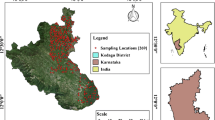Abstract
Updated and Accurate Digital Elevation Model (DEM) of snow covered and glaciated mountainous area is essential for many applications such as avalanche hazard and numerical modelling of mass movements or mapping of terrain changes. The best high resolution terrain product available for Himalayan region is the DEM, with a spatial resolution of 10 m, generated using Cartosat-1 stereo ortho-kit data. Even this spatial resolution is insufficient for many applications like avalanche hazard mapping or forecasting in complex mountainous terrain. This study reports the process of high spatial resolution (1 m) DEM generation for Manali and nearby areas using digital aerial photogrammetric survey data of 40 cm Ground Sampling Distance (GSD), captured through airborne ADS80 push-broom camera for the first time in Indian Himalayas. This DEM was also evaluated with Differential Global Positioning System (DGPS) points for accuracy assessment. The ADS80 DEM gave Root Mean Square Error (RMSE) of ∼<1 m and Linear Error, at 90 % confidence interval (LE 90) of 1.36 m in comparison with the DGPS points.











Similar content being viewed by others
References
Abdul-Rahman A Zlatanova SV, Coors V (2006) Innovations in 3D geo information systems. In: Proc. the 1st int. Workshop on 3D Geoinformation, Lect Notes in Geoinformation and Cartogr, Kuala, Springer, Heidelb
Aguilar F, Mills J, Delgado J, Aguilar M, Negreiros J, Perez J (2010) Modelling vertical error in LiDAR-derived digital elevation models. ISPRS J Photogramm Remote Sens 65:103–110
Avtar R, Sawada H (2012) Use of DEM data to monitor height changes due to deforestation. Arab J Geosci 6:4859–4871. doi:10.1007/s12517-012-0768-2
Bhambri R, Bolch T (2009) Glacier Mapping: A Review with special reference to the Indian Himalayas. Prog Phys Geogr 33(5):672–704. doi:10.1177/0309133309348112
Bühler Y, Marty M, Ginzler C (2012) High Resolution DEM Generation in High‐Alpine Terrain Using Airborne Remote Sensing Techniques. Trans GIS 16(5):635–647
Gehrke S, Morin K, Downey M, Boehrer N, Fuchs T (2010) Semi-global matching: An alternative to LIDAR for DEM generation. In: Proc of the 2010 Can Geomat Conf and Symp of Comm I
Gehrke S, Uebbing R, Downey M, Morin K (2011) Creating and using very high density point clouds derived from ADS imagery. In: Proc of the ASPRS Annu Conf, Milwaukee, Wisconsin
Geymen A (2012) Digital elevation model (DEM) generation using the SAR interferometry technique. Arab J Geosci. doi:10.1007/s12517-012-0811-3
Gharibi H (2012) Extraction and improvement of Digital Surface Models from Dense Point Clouds. In: Diss., Inst for Photogramm, Univ Stuttg
Giribabu D, Kumar P, Mathew J, Sharma KP, Murthy YVNK (2013) DEM generation using Cartosat-1 stereo data: issues and complexities in Himalayan terrain. Eur J Remote Sens 46:431–443
Guth PL (2006) Geomorphometry from SRTM: Comparison to NED. Photogramm. eng. & Remote Sens 72(3):269–277
Hirschmuller H (2005) Accurate and Efficient Stereo Processing by Semi-Global Matching and Mutual Information. In: Proc of the IEEE Conf on Comput Vis and Pattern Recognit, CVPR 2005 2: 807–814
Hirschmuller H (2008) Stereo processing by semiglobal matching and mutual information. IEEE Trans Pattern Anal Mach Intell 30(2):328–341
Hobi ML, Ginzler C (2012) Accuracy assessment of Digital Surface Models based on WorldView-2 and ADS80 stereo remote sensing data. Sensing 12(5):6347–6368
Hutchinson MF, Gallant JC (2000) Digital elevation models and representation of terrain shape. In: Wilson GJC et al (eds) Terrain Analysis; Principles and Applications. John Wiley and Sons, NY, pp 29–50
Li Z, Sui H (2000) An integrated technique for automated generalization of contour maps. Cartogr J 37(1):29–37
Li Z, Zhu Q, Gold C (2005) Digital Terrain Modeling: Principles and Methodology. CRC Press, Boca Raton, FL
Morin K, El-Sheimy N (2001) The Effects of Residual Errors in Airborne Laser Scanning Terrain Data on Ortho-Rectified Imagery. In: Proc of the Opt 3D Meas Tech V, Vienna, Austria
Mukherjee S, Joshi PK, Mukherjee S, Ghosh A, Garg RD, Mukhopadhyay A (2013) Evaluation of vertical accuracy of open source Digital Elevation Model (DEM). Int J Appl Earth Obs and Geoinformation 21:205–217
Muralikrishnan S, Pillai A, Narender B, Reddy S, Venkataraman VR, Dadhwal VK (2013) Validation of Indian National DEM from Cartosat-1 Data. J Indian Soc Remote Sens 41(1):1–13
Pradhan B, Youssef AM (2010) Manifestation of remote sensing data and GIS on landslide hazard analysis using spatial-based statistical models. Arab J Geosci 3:319–326
Rawashdeh SBA (2012) Assessment of extraction drainage pattern from topographic maps based on photogrammetry. Arab J Geosci 6:4873–4880. doi:10.1007/s12517-012-0718-z
Said AM, H H, Baharudin B (2009) Image-based modeling: a review. J Theor Appl Inf Technol 5(2):188–196
Snehmani, Singh MK, Gupta RD, Ganju A (2013a) DTM Generation and Avalanche Hazard Mapping using Large Format Digital Photogrammetric Data and Geomatics Technique. J Remote Sens GIS (JORSG) 4(2):4–13
Snehmani, Singh MK, Gupta RD, Ganju A (2013b) Extraction of high resolution DEM from Cartosat-1 stereo imagery using rational math model and its accuracy assessment for a part of snow covered NW-Himalaya. J Remote Sens GIS (JORSG) 4(2):23–34
Sulebak JR (2000) Applications of Digital Elevation Models. DYNAMAP Proj Oslo
Vázquez RF, Feyen J (2007) Assessment of the effects of DEM gridding on the predictions of basin runoff using MIKE SHE and a modelling resolution of 600 m. J Hydrol 334:73–87
Weibel R, Heller M (1993) Digital terrain modelling. Oxf Univ Press, Lond
Zaher MA, Saadi NM, Watanabeb K (2013) Geological applications potential of DEM, ETM+, and gravity data in arid and semi-arid regions with special reference to south Western Desert. Egypt Arab J Geosci. doi:10.1007/s12517-013-0847-z
Author information
Authors and Affiliations
Corresponding author
Rights and permissions
About this article
Cite this article
Singh, M.K., Snehmani, Gupta, R.D. et al. High resolution DEM generation for complex snow covered Indian Himalayan Region using ADS80 aerial push-broom camera: a first time attempt. Arab J Geosci 8, 1403–1414 (2015). https://doi.org/10.1007/s12517-014-1299-9
Received:
Accepted:
Published:
Issue Date:
DOI: https://doi.org/10.1007/s12517-014-1299-9




